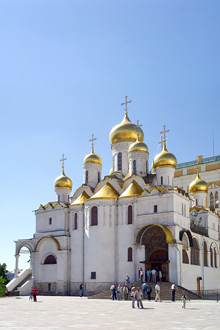See all Museums in Moscow
The Cathedral of the Annunciation
Moscow, Russia, 103073 Phone: 74956953776 http://www.moscow.info/kremlin/churches/cathedral-annunciation.aspxAbout
On the crest of Borovitsky Hill, at the south end of Sobornaya Ploshad (Cathedral Square), stands the Cathedral of the Annunciation. The first church was built on this spot as early as 1397 by order of Grand Duke Vassily I. The present building dates from 1484, when Ivan III (the Great), the great Muscovite empire-builder, ordered a new cathedral on the site. It was completed in 1489 by Krivtsov and Mishkin, masons from Pskov, who blended Greek and Russian styles in their design. Generations of princes and tsars added to and altered the Cathedral. Ivan IV (the Terrible) had the cathedral rebuilt in the 16th century and added four small side chapels, each with a single dome, while two more domes were added at the rear of the building and all nine domes were gilded. The Tsar was put under church penance when he married for the fourth time (three was the maximum the church would tolerate), and not allowed inside. This led to the construction of a new porch for him to stand under during services. The cathedral is famous for its magnificent iconostasis, shielding the sacred part of the church from view. Icons by various artists from the 14th to 19th centuries make up the screen. Icons on the diesis (prayer) tier are ascribed to the legendary Russian Painter Andrei Rublev, the greatest of the Russian icon-painters (whose work can also be seen in the State Tretyakov Gallery) and Theosofanus the Greek, possibly Rublev's mentor, with whom he frequently collaborated. The Cathedral of the Annunciation was originally built as the domestic church of the Grand Dukes and tsars and was connected (along with the Cathedral of the Archangel) by passages to the private quarters of the royal family. The cathedral was used to celebrate name-days, weddings, baptisms and so forth. The Cathedral of the Annunciation was badly damaged during the Revolution, when the Kremlin came under attack from artillery fire. In 1918, the cathedral was closed as a place of worship and now it operates officially as a museum.
